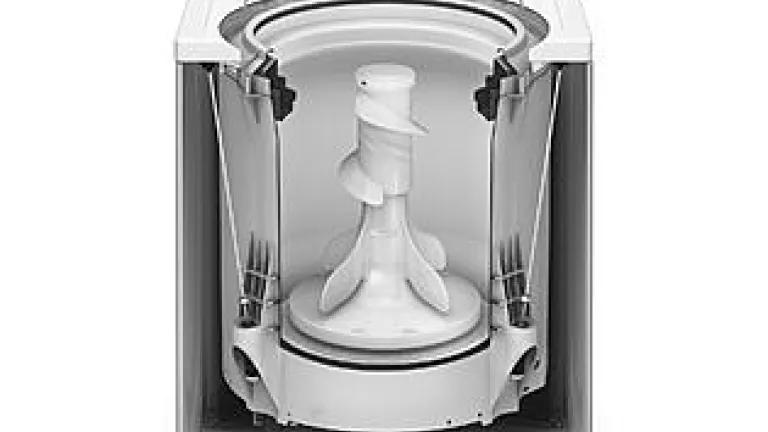
In California, we are well into our fourth consecutive year of bone dry and record hot conditions. This year-to-date is the hottest in recorded history--a sweltering 6.3 degrees above the 20th century average. And more than 98 percent of the state--an area home to more than 37 million people--is mired in drought.
With seemingly no end in sight to the state's worst drought in 1,200 years, we all must do what we can to save water. Last month Governor Jerry Brown announced a new round of actions to further reduce water use. In addition to calling for an overall 25 percent reduction in urban water use, Governor Brown also announced plans for a statewide incentive program to replace appliances like inefficient clothes washers.
- Typical design of an old, inefficient top-loading clothes washer
While people commonly think of toilets and faucets (and even showers) as the greatest users of water indoors, older top-loading clothes washers--found in more than 4 million homes in California--are water guzzlers. The average basic top-loading clothes washer purchased brand new less than a decade ago swallows more than 40 gallons of water per load. That's more than 12,000 gallons of water each year...or enough water to fill 300 bathtubs. Older clothes washers waste even more water.
In sharp contrast, thanks to stronger federal efficiency standards, today's most efficient clothes washers (such as those rated by ENERGY STAR) use fewer than 14 gallons of water per load. That's a savings of more than 8,000 gallons per year, which is enough to reduce the average household's annual water use by about 5 percent. If every old, top-loading clothes washer in California was replaced with a new ENERGY STAR model, more than 32 billion gallons of water would be saved each year--equivalent to the average amount of water used by roughly 630,000 people.
Higher efficiency clothes washers not only save water, but they also use less than half the energy of older units. That's why many energy and water utilities provide customer rebates, ranging from $35 to more than $300, on the purchase of these models. While details on the upcoming statewide appliance rebate program have not been announced, the new rebate on top of existing rebates will make it the perfect time to replace your old water guzzler. You can find out more information about the most efficient washers and see which models qualify for a rebate in your area by visiting enervee.
Although programs for incentivizing the purchase of higher efficiency clothes washers are important, making sure that old, inefficient units are recycled is equally critical. Old clothes washers that are replaced by new units oftentimes are given away or sold and remain in use, continuing to waste water and energy. We have been working diligently through the California Technical Forum to push utilities to collaborate on recycling programs that pay customers to recycle their old washer--much in the way that many utilities pay customers to recycle their old refrigerator or freezer.
We recently received approval for a proposed method to account for the water and energy savings from recycling clothes washers--an initial victory that paves the way for a program to be offered. Such a program would provide an incentive for households to recycle their old washer instead of selling it or giving it away, ensuring that these inefficient water and energy-wasting machines are permanently destroyed. We continue to engage with utilities and remain hopeful that one or more of them will soon offer a recycling program. Programs that make it easier for families to replace and recycle their old water-guzzling clothes washer can play a part in saving water during this drought crisis and for years to come.